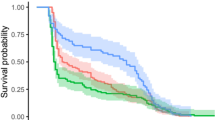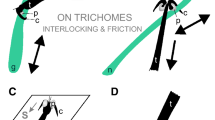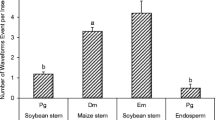Abstract
Many mirid bugs are omnivores, and several species are key pests of agricultural crops. While mirid feeding behavior on plant hosts is relatively well studied, little attention has been paid to foraging, acceptance, and consumption of insect prey items. In this study, we investigated the feeding behavior and stylet penetration of the green mirid bug Apolygus lucorum on insect prey (Helicoverpa armigera eggs), plant hosts (green bean Phaseolus vulgaris pod), and combined plant + prey diets. Direct observation and electrical penetration graph (EPG) assays were used to assess feeding on either food item. Overall feeding time was highest on combined diets (48.18 ± 4.92 % of total time) and plant foods (42.23 ± 3.36 %), compared with only 28.95 ± 2.27 % feeding time on H. armigera eggs. When exposed to combined diets, A. lucorum spent 3.8 times longer feeding on green bean pod than on H. armigera eggs. The overall duration of stylet penetration was 5866.27 ± 800.39 s on green bean pod versus 3644.81 ± 715.19 s on H. armigera eggs, representing a 37.87 % reduction in duration. Similarly, the duration of a single probing event was significantly higher on green bean pod (355.76 ± 50.13 s) versus H. armigera eggs (236.20 ± 25.17 s), with a 33.61 % reduction. This first work in which omnivory is studied by combined use of observational studies and EPG assays (1) provides further insights into A. lucorum omnivory, (2) further elucidates its trophic position in agroecosystems, and (3) guides the development of artificial diets for this pest species.




Similar content being viewed by others
References
Agustí N, Cohen AC (2000) Lygus hesperus and L. lineolaris (Hemiptera: Miridae), phytophages, zoophages, or omnivores: evidence of feeding adaptations suggested by the salivary and midgut digestive enzymes. J Entomol Sci 35:176–186
Alvarez AE, Tjallingii WF, Garzo E, Vleeshouwers V, Dicke M, Vosman B (2006) Location of resistance factors in the leaves of potato and wild tuber-bearing Solanum species to the aphid Myzus persicae. Entomol Exp Appl 121:145–157
Backus EA (1988) Sensory systems and behaviours which mediate hemipteran plant-feeding: a taxonomic overview. J Insect Physiol 34:151–165
Backus EA, Bennett WH (2009) The AC–DC correlation monitor: new EPG design with flexible input resistors to detect both R and emf components for any piercing–sucking hemipteran. J Insect Physiol 55:869–884
Backus EA, Habibi J, Yan F, Ellersieck M (2005) Stylet penetration by adult Homalodisca coagulata on grape: electrical penetration graph waveform characterization, tissue correlation, and possible implications for transmission of Xylella fastidiosa. Ann Entomol Soc Am 98:787–813
Bauer PJ, McAlister DD III, Roof ME (2006) Evidence that light stink bug damage does not influence open end yarn processing performance. J Cotton Sci 10:161–167
Bernays EA, Funk DJ (1999) Specialists make faster decisions than generalists: experiments with aphids. Proc R Soc Lond B 266:151–156
Cai X, Wu K, Yuan G (2008) Electrical penetration graphs of Adelphocoris suturalis Jakovlev in main host crops, China. Sci Agric Sin 41:431–436
Castane C, Arno J, Gabarra R, Alomar O (2011) Plant damage to vegetable crops by zoophytophagous mirid predators. Biol Control 59:22–29
Civolani S, Leis M, Grandi G, Garzo E, Pasqualini E, Musacchi S, Chicca M, Castaldelli G, Rossi R, Tjallingii WF (2011) Stylet penetration of Cacopsylla pyri: an electrical penetration graph (EPG) study. J Insect Physiol 57:1407–1419
Cline AR, Backus EA (2002) Correlations among AC electronic monitoring waveforms, body postures, and stylet penetration behaviors of Lygus hesperus (Hemiptera: Miridae). Environ Entomol 31:538–549
Cui L, Sun L, Yang D, Yan X, Yuan H (2012) Effects of cycloxaprid, a novel cis-nitromethylene neonicotinoid insecticide, on the feeding behaviour of Sitobion avenae. Pest Manag Sci 68:1484–1491
Díaz MF, Ramírez A, Poveda K (2012) Efficiency of different egg parasitoids and increased floral diversity for the biological control of noctuid pests. Biol Control 60:182–191
Dittmar L, Stürzl W, Jetzschke S, Mertes M, Boeddeker N (2014) Out of the box: how bees orient in an ambiguous environment. Anim Behav 89:13–21
Dittrich-Schröder G, Harney M, Neser S, Joffe T, Bush S, Hurley BP, Wingfield MJ, Slippers B (2014) Biology and host preference of Selitrichodes neseri: a potential biological control agent of the Eucalyptus gall wasp, Leptocybe invasa. Biol Control 78:33–41
Dugravot S, Backus EA, Reardon BJ, Miller TA (2008) Correlations of cibarial muscle activities of Homalodisca spp. sharpshooters (Hemiptera: Cicadellidae) with EPG ingestion waveform and excretion. J Insect Physiol 54:1467–1478
Gillespie DR, McGregor RR (2000) The functions of plant feeding in the omnivorous predator Dicyphus hesperus: water places limits on predation. Ecol Entomol 25:380–386
Hagler JR (2009) Comparative studies of predation among feral, commercially-purchased, and laboratory-reared predators. BioControl 54:351–361
Hagler JR, Blackmer JL (2007) Potassium chloride deters Lygus hesperus feeding behavior. Entomol Exp Appl 124:337–345
Hagler JR, Jackson CG, Isaacs R, Machtley SA (2004) Foraging behavior and prey interactions by a guild of predators on various lifestages of Bemisia tabaci. J Insect Sci 4:1
Hagler JR, Jackson CG, Blackmer JL (2010) Diet selection exhibited by juvenile and adult lifestages of the omnivores western tarnished plant bug, Lygus hesperus and tarnished plant bug, Lygus lineolaris. J Insect Sci 10:127
Ingegno BL, Pansa MG, Tavella L (2011) Plant preference in the zoophytophagous generalist predator Macrolophus pygmaeus (Heteroptera: Miridae). Biol Control 58:174–181
Jaastada G, Trandemb N, Hovlanda B, Moganc S (2009) Effect of botanically derived pesticides on mirid pests and beneficials in apple. Crop Prot 28:309–313
Jiang YX, Walker GP (2003) Electrical penetration graphs of the nymphal stage of Bemisia argentifolii. Entomol Exp Appl 109:101–111
Jiang YX, Nombela G, Muniz M (2001) Analysis by DC-EPG of the resistance to Bemisia tabaci on an Mi-tomato line. Entomol Exp Appl 99:295–302
Jin S, Chen ZM, Backus EA, Sun XL, Xiao B (2012) Characterization of EPG waveforms for the tea green leafhopper, Empoasca vitis Gothe (Hemiptera: Cicadellidae), on tea plants and their correlation with stylet activities. J Insect Physiol 58:1235–1244
Lei H, Lenteren JCV, Tjallingii WF (1999) Analysis of resistance in tomato and sweet pepper against the greenhouse whitefly using electrically monitored and visually observed probing and feeding behavior. Entomol Exp Appl 92:299–309
Li G, Feng H, McNeil JN, Liu B, Chen P, Qiu F (2011) Impacts of transgenic Bt cotton on a non-target pest, Apolygus lucorum (Meyer-Dür) (Hemiptera: Miridae), in northern China. Crop Prot 30:1573–1578
Liang GM, Wu KM, Yu HK, Li KK, Feng X, Guo YY (2008) Changes of inheritance mode and fitness in Helicoverpa armigera (Hübner) (Lepidoptera: Noctuidae) along with its resistance evolution to Cry1Ac toxin. J Invertebr Pathol 97:142–149
Lu YH, Wu KM (2008) A rearing method for mirids using the green bean, Phaseolus vulgaris in the laboratory. Acta Phytophyl Sin 35:215–219
Lu YH, Wu KM (2011) Mirid bugs in China: pest status and management strategies. Outlooks Pest Manag 22:248–252
Lu YH, Qiu F, Feng HQ, Li HB, Yang ZC, Wyckhuys KAG, Wu KM (2008) Species composition and seasonal abundance of pestiferous plant bugs (Hemiptera: Miridae) on Bt cotton in China. Crop Prot 27:465–472
Lu YH, Wu KM, Wyckhuys KAG, Guo YY (2009) Potential of mungbean, Vigna radiatus as a trap crop for managing Apolygus lucorum (Hemiptera: Miridae) on Bt cotton. Crop Prot 28:77–81
Lu YH, Wu KM, Jiang YY, Xia B, Li P, Feng HQ, Wyckhuys K, Guo YY (2010) Mirid bug outbreaks in multiple crops correlated with wide-scale adoption of Bt cotton in China. Science 328:1151–1154
Marchetti E, Civolani S, Leis M, Chicca M, Tjallingii WF, Pasqualini E, Baronio P (2009) Tissue location of resistance in apple to the rosy apple aphid established by electrical penetration graphs. Bull Insectol 62:203–208
Mclean DL, Kinsey MG (1964) A technique for electronically recording aphid feeding and salivation. Nature 202:1358–1359
Miao J, Han B (2007) Probing behavior of the tea green leafhopper on different tea plant cultivars. Acta Ecol Sin 27:3973–3982
Naranjo SE (2011) Impacts of Bt transgenic cotton on integrated pest management. J Agric Food Chem 59:5842
Patil BV, Bheemanna M, Patil SB, Udikeri SS, Hosmani A (2006) Record of mirid bug, Creontiodes biseratense (Distant) on cotton from Karnataka, India. Insect Environ 11:176–177
Perdikis D, Lucas E, Garantonakis N, Giatropoulos A, Kitsis P, Maselou D, Panagakis S, Lampropoulos P, Paraskevopoulos A, Lykouressis D, Fantinou A (2014) Intraguild predation and sublethal interactions between two zoophytophagous mirids, Macrolophus pygmaeus and Nesidiocoris tenuis. Biol Control 70:35–41
SAS Institute (2005) SAS/STAT user’s guide. SAS Institute, Cary
Stafford CA, Walker GP (2009) Characterization and correlation of DC electrical penetration graph waveforms with feeding behavior of beet leafhopper, Circulifer tenellus. Entomol Exp Appl 130:113–129
Tan YA, Xiao LB, Sun Y, Zhao J, Bai LX (2014) Sublethal effects of the chitin synthesis inhibitor, hexaflumuron, in the cotton mirid bug, Apolygus lucorum (Meyer-Dür). Pestic Biochem Phys 111:43–50
Trebicki P, Tjajjingii WF, Harding RM, Rodoni BC, Powell KS (2012) EPG monitoring of the probing behavior of the common brown leafhopper Orosius orientalis on artificial diet and selected host plants. Arthropod Plant Interact 6:405–415
Vankosy MA, Van Laerhoven SL (2015) Plant and prey quality interact to influence the foraging behavior of an omnivorous insect, Dicyphus hesperus. Anim Behav 108:109–116
Wang LL (2010) Predation of Apolygus lucorum to cotton insect pests and its molecular detection. Master dissertation, Chinese Academy of Agricultural Sciences, Beijing
Wheeler AG (2001) Biology of the plant bugs (Hemiptera: Miridae): pests, predators, opportunists. Cornell University Press, Ithaca
Wu KM (2007) Environmental impacts and risk management strategies of Bt cotton commercialization in China. J Agric Biotechnol 15:1–4
Wu K, Li W, Feng H, Guo Y (2002) Seasonal abundance of the mirids, Lygus lucorum and Adelphocoris spp. (Hemiptera: Miridae) on Bt cotton in northern China. Crop Prot 21:997–1002
Yuan W, Li WJ, Lu YH, Wu KM (2013) Combination of plant and insect eggs as food sources facilitates ovarian development in an omnivorous bug Apolygus lucorum (Hemiptera: Miridae). J Econ Entomol 106:1200–1208
Zhou YL, Zhao QJ, Zhang YJ, Guo YY (2013) Electrical penetration graph analysis of Apolygus lucorum on artificial diet model, China. J Environ Entomol 35:441–444
Acknowledgments
This research was supported by the National Natural Science Foundation of China (31371948).
Author information
Authors and Affiliations
Corresponding author
Additional information
Handling Editors: James Hagler and Heikki Hokkanen.
Rights and permissions
About this article
Cite this article
Li, W., Wyckhuys, K.A.G. & Wu, K. Does feeding behavior of a zoophytophagous mirid differ between host plant and insect prey items?. Arthropod-Plant Interactions 10, 79–86 (2016). https://doi.org/10.1007/s11829-015-9410-z
Received:
Accepted:
Published:
Issue Date:
DOI: https://doi.org/10.1007/s11829-015-9410-z




